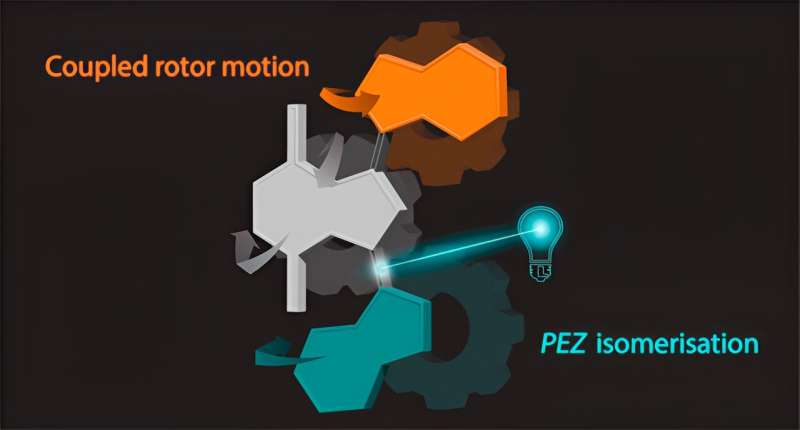March 5, 2024 report
This article has been reviewed according to Science X's editorial process and policies. Editors have highlighted the following attributes while ensuring the content's credibility:
fact-checked
peer-reviewed publication
trusted source
proofread
Communication between rotors in molecular motor observed for the first time

A pair of chemists at the University of Groningen in the Netherlands, has observed communication between rotors in a molecular motor. In their study, reported in the Journal of the American Chemical Society, Carlijn van Beek and Ben Feringa conducted experiments with alkene-based molecular motors.
Molecular motors are natural or artificial molecular machines that convert energy into movement in living organisms. One example would be DNA polymerase turning single-stranded DNA into double-stranded DNA. In this new effort, the researchers were experimenting with light-driven, alkene-based molecular motors, using light to drive molecular rotors. As part of their experiments, they created a motor comprising three gears and two rotors and observed an instance of communication between two of the rotors.
To build their motor, the researchers started with parts of existing two motors, bridging them together. The resulting isoindigo structure, they found, added another dimension to their motor relative to other synthesized motors—theirs had a doubled, metastable intermediary connecting two of the rotors, allowing for communication between the two.
This, they note, meant that one rotor did not have to complete a rotation before the second was activated, as is the normal case. And this led to changes in the structure that drove the central core of the motor, which in turn influenced the movement of the second rotor—an example of communication between the two rotors.
To observe their motor in action, the researchers combined NMR and UV-visible spectroscopy. They also ran their motor in a chamber chilled to –110°C to slow down the action to make it visible as the events unfolded. This allowed them to watch the motor in step-by-step detail.
The researchers also conducted DFT experiments that allowed them to characterize all the structures that were possible given the motor parts they had available. They acknowledge that they were unable to find an explanation for the communication mechanism that arose in their motor, though they suggest their findings could provide a better understanding of the types of coupling that can occur in molecular motors.
More information: Carlijn L. F. van Beek et al, Coupled Rotary Motion in Molecular Motors, Journal of the American Chemical Society (2024). DOI: 10.1021/jacs.3c14430
Journal information: Journal of the American Chemical Society
© 2024 Science X Network





















